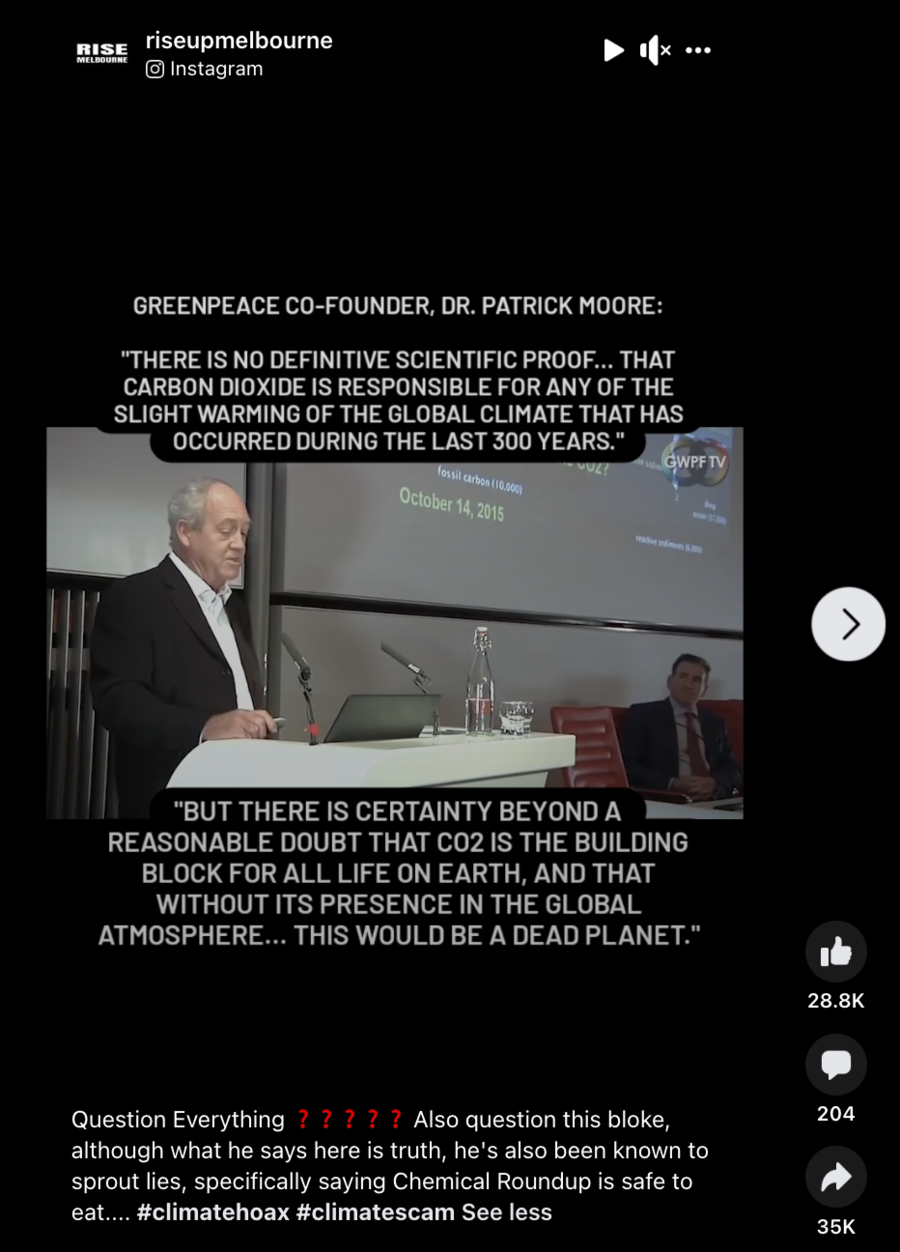
Does the impact of carbon dioxide on global warming have "no definitive scientific proof through real-world observation"? No, that's not true: Relying on numerous credible observational studies coupled with an understanding of physics, chemistry and statistical analysis, contemporary science considers increased levels of CO₂ one of the major factors responsible for climate change.
The claim appeared in a reel on Facebook on June 8, 2023, republished from Instagram where it was posted on June 8, 2023. The video showed a neatly dressed middle-aged man in what appeared to be a conference setting. He said:
As I stated publicly on many occasions, there is no definitive scientific proof through real-world observation that carbon dioxide is responsible for any of the slight warming of the global climate that has occurred during the last 300 years since the peak of the Little Ice Age. If there were such a proof through testing and replication, it would have been written down for all of us to see. The contention that human emissions are now the dominant influence on climate is simply a hypothesis rather than a universally accepted scientific theory.
(Source: Facebook screenshot taken on Thu Jun 15 14:37:56 2023 UTC)
The man portrayed in the video is Patrick Moore, a former president of Greenpeace Canada and a co-founder of Greenpeace International who left the organization in 1986 and then became a lobbyist for a number of industries, speaking publicly against the environmental movement.
As the date shown behind Moore on the projector screen indicated, the recording was made on October 14, 2015.
The speech omits important context.
Carbon dioxide (CO₂) is a vital element keeping the Earth livable. Without it, the atmosphere wouldn't be able to accumulate enough heat needed for living organisms to survive. For decades, that has been a universally accepted reality, and even Moore did not doubt it in the clip shared on social media.
The problem is that humankind now produces much more carbon dioxide than can be recycled by natural processes ensuring the proper atmospheric composition, explains National Oceanic and Atmospheric Administration's resource Climate.gov:
Carbon cycle experts estimate that natural 'sinks'--processes that remove carbon from the atmosphere--on land and in the ocean absorbed the equivalent of about half of the carbon dioxide we emitted each year in the 2011-2020 decade. Because we put more carbon dioxide into the atmosphere than natural sinks can remove, the total amount of carbon dioxide in the atmosphere increases every year.
While acknowledging that the planet saw natural fluctuations in CO₂ levels, Climate.gov shows the data, confirming that the present carbon dioxide concentrations are much higher than what occurred during pre-industrial increases:
Based on the annual report from NOAA's Global Monitoring Lab, global average atmospheric carbon dioxide was 417.06 parts per million ('ppm' for short) in 2022, setting a new record high. [...]
By adding more carbon dioxide to the atmosphere, people are supercharging the natural greenhouse effect, causing global temperature to rise. According to observations by the NOAA Global Monitoring Lab, in 2021 carbon dioxide alone was responsible for about two-thirds of the total heating influence of all human-produced greenhouse gases. [...]
Based on air bubbles trapped in mile-thick ice cores and other paleoclimate evidence, we know that during the ice age cycles of the past million years or so, atmospheric carbon dioxide never exceeded 300 ppm. Before the Industrial Revolution started in the mid-1700s, atmospheric carbon dioxide was 280 ppm or less.
The 2015 Moore speech, as posted online in 2023, did not address that circumstance at all.
Contrary to the claim, the climate section of the European Commission website also describes CO₂ as one of the major contributing factors to climate change:
As every tonne of CO2 emitted contributes to global warming, all emissions reductions contribute to slowing it down. In order to stop global warming completely, CO2 emissions have to reach net zero worldwide. In addition, reducing emissions of other greenhouse gases, such as methane, can also have a powerful effect on slowing global warming - especially in the short term.
Jason Smerdon, a climate scientist at Columbia University's Lamont-Doherty Earth Observatory, offers an in-home experiment illustrating the same concept at a much smaller scale:
Smerdon recommends filling one soda bottle with CO2 (perhaps from a soda machine) and filling a second bottle with ambient air. 'If you expose them both to a heat lamp, the CO2 bottle will warm up much more than the bottle with just ambient air,' he says. He recommends checking the bottle temperatures with a no-touch infrared thermometer. You'll also want to make sure that you use the same style of bottle for each, and that both bottles receive the same amount of light from the lamp.
The video of the experiment is available here.
The Environmental Protection Agency website lists other pieces of evidence confirming climate change, linking them to carbon dioxide:
- Changing temperature and precipitation patterns.
- Increases in ocean temperatures, sea level, and acidity.
- Melting of glaciers and sea ice.
- Changes in the frequency, intensity, and duration of extreme weather events.
- Shifts in ecosystem characteristics, like the length of the growing season, timing of flower blooms, and migration of birds.
These changes are due to a buildup of greenhouse gases in our atmosphere and the warming of the planet due to the greenhouse effect.
As of 2022, scientists learned how to separate man-produced and naturally occurring CO₂:
Previous studies investigated the effects of lockdowns early in the pandemic and found that global CO2 levels dropped slightly in 2020. However, by combining OCO-2's high-resolution data [NASA's Orbiting Carbon Observatory-2] with modeling and data analysis tools from NASA's Goddard Earth Observing System (GEOS), the team was able to narrow down which monthly changes were due to human activity and which were due to natural causes at a regional scale. This confirms previous estimates based on economic and human activity data.
The team's measurements showed that in the Northern Hemisphere, human-generated growth in CO2 concentrations dropped from February through May 2020 and rebounded during the summer, consistent with a global emissions decrease of 3% to 13% for the year.
The most recent breakdown per country, helping to track the impact of multiple factors, including deforestation, is available here.
The United Nations website emphasizes that excessive CO₂ may be stored in the atmosphere for centuries, and, thus, the overall impact of previous decades is not likely to be reversed overnight:
WMO warns that as long as emissions continue, global temperature will continue to rise. Given the long life of CO2 in the atmosphere, the temperature level already observed will persist for decades even if emissions are rapidly reduced to net zero.
While many aspects of climate change are well understood by today's science, some others have to be studied more. One of them is the exact magnitude of its cumulative effects, which, at this point, appears to be a range, reads an article published by the National Bureau of Economic Research, a private nonprofit organization "governed by a Board of Directors consisting of 51 members from leading North American research universities, economics professional organizations, and the business and labor communities."
Yet, the contribution of CO₂ to climate change is considered a scientific consensus.
Debunking a similar claim made by another climate skeptic, AAP Factcheck wrote that when it comes to climate change, science relies on the overwhelming body of evidence, accumulated over years. Given that it is a multidimensional process with numerous variables, the concept of "proof" as it is understood in linear math is not fully applicable to this field.
While the ability to replicate an experiment with the exact same conditions and reach the same result is considered a golden standard, science has its limitations, too: Any reasonable person would agree that humankind doesn't have another Earth, with the same population and distribution of economic activities, and the opportunity to go backward and forward in time to be able to experiment with variables.
Other Lead Stories fact checks about climate can be found here.















